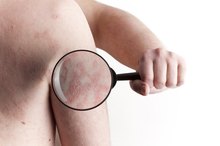After-Care Instructions for a TCA Peel
Seeking beauty treatments is a seemingly endless pursuit, and thanks to trichloroacetic acid peels, it is becoming easier. Flocking to plastic surgeons and dermatologists for this rejuvenating chemical peel, people want to reduce fine wrinkles, blemishes and superficial pigmentation and bring an improved appearance of healthier, smoother and younger skin 1. Knowing how to care for your skin after a medium-depth TCA peel can make all the difference in achieving favorable results.
Ask a friend or family member to drive you home and stay with you for at least 24 hours. Prepping you with sedation or providing pain medication after the TCA peel means that you are not safe to drive yourself home. Have him bring you food, ice packs, check on you through the night or call your doctor if problems arise. Consider a private duty nurse as an alternative.
How to Reduce Redness After a Chemical Peel
Learn More
Elevate your head with pillows or a backrest. Keeping your head elevated for two to three days after the peel will reduce recovery time and help reduce swelling. Ignoring this could prolong healing and/or cause asymmetries of the face.
Reduce swelling by using an ice pack for 24 to 48 hours. Put crushed ice into a plastic bag, seal it carefully, wrap in small towel and apply to treated skin. Alternatives could be frozen peas or corn. These bagged vegetables are reusable, do not leak and conform in shape. Taking anti-inflammatories -- such as aspirin or ibuprofen -- for 24 to 48 hours will also reduce swelling, but check with your doctor before taking one of these medications.
A Chemical Peel for Enlarged Pores
Learn More
Soak treated area with 0.25 percent acetic acid. Wash hands. Mix 1 tablespoon white vinegar with 1 pint warm water. Dip gauze or clean cotton washcloth in solution and wring out excess. Apply this compress four times each day.
Keep skin moist. Use an emollient -- oils, lotions, ointments -- as directed by your physician. Moistening skin consistently will promote healing and ease discomfort. Poor results and scarring can occur if skin is allowed to dry out or crack. Flaking will also be reduced.
Avoid touching skin. Itching, rubbing and picking scabs could increase the risk of infection and scarring as well as decrease even-colored skin tone. Do not pop open any blisters that form.
Apply sunscreen with an SPF rating of 15 to 40 every day. Exposing this new, tender skin to ultraviolet light can be dangerous. Use extreme caution when outdoors for the first year after the peel. It is wise to apply sunscreen under makeup, even when you plan to be indoors most of the day.
Tips
TCA peels are considered cosmetic and therefore seldom covered by insurance. Check with your insurance company before scheduling treatment.
Increase your water intake. Ten to 12 glasses per day are recommended.
Wear a hat outdoors for increased protection from the sun.
All chemical peels carry some risk and are not guaranteed. Do your homework.
Warnings
Do-it-yourself TCA peels are now available to consumers. Exercise great caution when purchasing or using. Concentrations can fluctuate and be dangerous or ineffective. Check the manufacturing company with the Better Business Bureau and consult your health care provider.
Do not smoke until healing is complete. Side effects can include infection and scarring.
Check with physician before showering or washing hair.
Consult with physician before taking any vitamins or herbal supplements. Not all are harmless.
Resume exercising only at the recommendation of your health care provider.
Related Articles
References
- American Society of Plastic Surgeons: Chemical Peel
- Aging Skin Net: Chemical Peeling
- O'connor AA, Lowe PM, Shumack S, Lim AC. Chemical peels: a review of current practice. Australas J Dermatol. 2018;59(3):171-181. doi:10.1111/ajd.12715
- Castillo DE, Keri JE. Chemical peels in the treatment of acne: patient selection and perspectives. Clin Cosmet Investig Dermatol. 2018;11:365–372. doi:10.2147/CCID.S137788
- Soleymani T, Lanoue J, Rahman Z. A practical approach to chemical peels: a review of fundamentals and step-by-step algorithmic protocol for treatment. J Clin Aesthet Dermatol. 2018;11(8):21–28.
- Cleveland Clinic. Chemical peels: what to expect.
- Cleveland Clinic. Chemical peels: how to prepare.
- Stanford Healthcare. Techniques: our approach to chemical skin peels.
- Cleveland Clinic. What results can I expect?.
Writer Bio
Jean Jenkins has been writing professionally since 1994. She has written medical research materials for the American Parkinson's Association, the Colorado Neurological Institute and the Autism Society of America. Jenkins has specialized in neurology, labor and delivery, high-risk obstetrics and autism spectrum disorders. She holds a Bachelor of Science in nursing from the University of Colorado.









